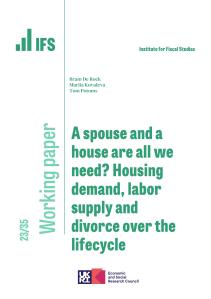The ‘affordability’ of housing is one of the most prominent domestic public policy issues of the day, and for good reason. The housing that people are in is an important determinant of their well-being, and it is something on which people – especially those on lower incomes – typically spend a substantial fraction of their income. Changes in the price of obtaining a given standard of housing can therefore significantly affect living standards. This report documents changes in housing tenure and analyses changes in the cost of renting.
The rise of renting |
| |
Declines in homeownership and in social housing mean many more people are renting privately, especially among the young. | The overall proportion of the population of Great Britain who live in rented accommodation has risen to 35%, up from 29% in the mid 1990s. But this growth has been entirely in the private rather than social sector and heavily concentrated among the young. Just 12% of 25- to 34-year-olds rented privately in the mid 1990s. This has since trebled to 37%. | |
The rise of private renting has been spread quite evenly across the income distribution. | The shift towards private renting largely reflects falls in owner-occupation towards the top and (especially) the middle of the income distribution; and falls in social renting towards the bottom of the distribution. | |
Rents and incomes |
| |
Renters are paying considerably more for their homes than 20 years ago, though in the private sector this is due to trends before the recession. | Relative to the general price level, the average (median) private rent paid in the mid 2010s was 53% higher than that in the mid 1990s in London and 29% higher in the rest of Britain. Those rises mainly occurred in the late 1990s and early 2000s (in London) or in the early and mid 2000s (in the rest of Britain). By contrast, social housing rents consistently grew in real terms from the mid 1990s until the (temporary) changes to social rent uprating policy from 2016. | |
These higher rents paid do not seem to be explained by changes in the characteristics of rented properties. | Detailed data on housing characteristics available within England show that, for the most part, increases in private rents paid since the turn of the century are not explained by improvements in the quality of property in the private rented sector. Rather, people generally seem to be paying more for similar properties. | |
Londoners spend more of their income on rent than renters elsewhere and the differential between London and the rest of the country has increased recently. | In 2013‒2015, the average (median) rent-to-income ratio among private renters was 40% in London and 28% in the rest of Great Britain. This ratio increased by 5 percentage points (ppts) in London between 2006–2008 and 2013–2015, while not changing in the rest of Great Britain. This is because the incomes of private renters have fallen in London whereas they have flatlined in other parts of the country. | |
Low-income households: rents, incomes and housing benefit | ||
Low-income renters spend a higher portion of their income on rent than higher-income renters, even after accounting for the help they get through housing benefit (HB). | When comparing income groups, we look at rent-to-income ratios excluding housing benefit (HB) from rent and income: how much of their other income must renters use to pay the part of their rent not covered by HB? On this measure, the median rent-to-income ratio is 35% among private renters in the bottom income quintile, 24% in the middle quintile and 19% in the top quintile. | |
This differential has risen over time. | The median rent-to-income ratio among private renters in the top two income quintiles is about the same as two decades ago. But it is higher than two decades ago for the bottom half of the income distribution. | |
The proportion of low-income renters who do not have all of their rent covered by HB has risen. | Looking just at low-income renters in the private sector (those in the bottom 40% of the income distribution in each region), the fraction whose housing benefit does not cover all of their rent has increased quite steadily, from 74% in the mid 1990s to 90% in the mid 2010s. The biggest change occurred among low-income working-age households with children, where it rose from 63% to 90% over the same period. In the social housing sector, the increase has been concentrated in recent years, jumping from 56% in 2010‒2012 to 68% in 2013‒2015. | |
The impacts of housing benefit reforms | ||
Significant cuts to the generosity of HB have been made since 2011. | We estimate that reforms since 2011 have cut the HB entitlements of 1.9 million privately renting households (containing 4.8 million people) and 600,000 social-renting households (containing 1.3 million people). This includes two-thirds of low-income private renters and one-sixth of low-income social renters. | |
Those cuts have significantly increased the number of low-income renters whose HB entitlement falls short of their rent. | The proportion of low-income renters with a ‘shortfall’ between rent and HB entitlement is 12ppts higher in the private sector (an extra 600,000 people), and 10ppts higher in the social sector (an extra 700,000 people), than it would have been without the cuts made since 2011. | |
Private sector tenants will continue to be affected by the policy not to increase HB caps in line with local rents. | Instead, these caps will, for the most part, be frozen until April 2020 and then increased in line with general prices. Between now and 2025, we estimate that, relative to local rent indexation, this will result in another 4% of low-income private renters (or 200,000 people) facing a shortfall between HB entitlement and rent. It will also increase the proportion facing an especially large shortfall, of at least 50% of (non-HB) income, by 2ppts (an extra 100,000 people), and by 5ppts (50,000 people) in London. | |
The system of locally varying HB caps is also set to be gradually rolled out to the social rented sector from April 2019. | If done now, this would mean an extra 3% of low-income social renters (an extra 200,000 people) with a shortfall between HB entitlement and rent. Although significant, this is a smaller impact than seen from the recent reforms already implemented. One reason for this is that the caps were (until recently) linked to private sector rent levels. Since rents in social housing are lower, they fall below these caps relatively often. | |
The impacts of these caps on social tenants will be larger for some groups, however. | These groups include tenants renting from a housing association (HA) rather than a local authority, and households without children. This is at least in part because rents in HA properties and in smaller properties tend to be closer to private sector levels, making the caps more binding. | |











